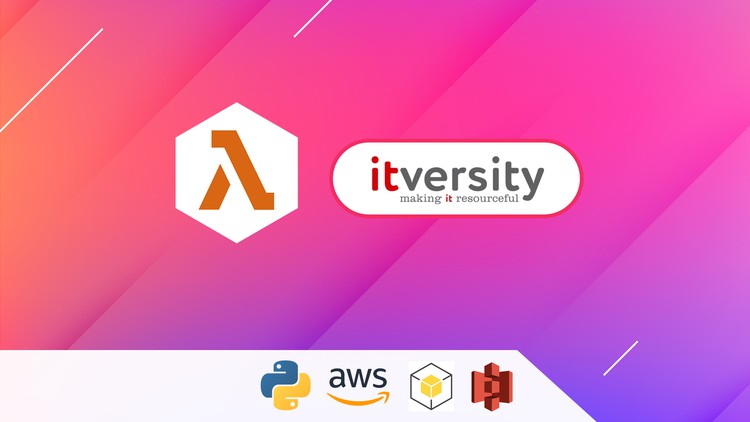
Learn how to get started with AWS Lambda Functions using Python run time for free
What you will learn
Overview of AWS Lambda and Getting Started using Python 3
Passing Arguments to AWS Lambda and Processing using Python
Using Custom Handlers for AWS Lambda Functions using Python 3
Using AWS Services such as s3 in AWS Lambda Functions
Recap of handling permissions using AWS IAM Roles and User Groups
Develop AWS Lambda Function to list objects from AWS S3 Bucket
Passing Environment Variables to AWS Lambda Functions
Customizing Resources such as memory used for AWS Lambda Function
Setup Local Development Environment for AWS Lambda Functions
Develop logic to for AWS Lambda Function using external packages
Build Zip file to deploy as AWS Lambda Function
Deploy Application with External Dependencies as AWS Lambda Function
Description
As part of this free course, you will learn how to get started with AWS lambda functions using Python run time. Here is the high-level outline for the course. AWS Lambda is one of the most popular fully managed AWS Services supporting different run times. As the IT Industry has adapted microservices architecture, serverless functions become a vital component in building large-scale complex applications.
- Overview of AWS Lambda and Getting Started using Python 3
- Passing Arguments to AWS Lambda and Processing using Python
- Using Customer Handlers for AWS Lambda Functions using Python 3
- Using AWS Services such as s3 in AWS Lambda Functions
- Recap of handling permissions using AWS IAM Roles and User Groups
- Develop AWS Lambda Function to list objects from AWS S3 Bucket
- Passing Environment Variables to AWS Lambda Functions
- Customizing Resources such as memory used for AWS Lambda Function
- Setup Local Development Environment for AWS Lambda Functions
- Develop logic for AWS Lambda Function using external packages
- Build Zip file to deploy as AWS Lambda Function
- Deploy Application with External Dependencies as AWS Lambda Function
Here is the detailed outline for the course.
- First, you will start with prerequisites such as having a valid AWS account as AWS Lambda Functions are supposed to be deployed as part of the AWS Account.
- Once you have a valid AWS account, you will understand what AWS Lambda is and how to deploy the first application using Python 3 run-time using AWS Web Console.
- We should be able to pass arguments to any applications including AWS Lambda Functions. After deploying the first application as AWS Lambda Function, you will understand how to pass arguments at run time and process as part of the application.
- When we use AWS Web Console to deploy the application as AWS Lambda Function using a blueprint, it uses the default handler. But when we start developing the applications, we might end up having multiple lambda functions as part of one deployed code base which means you need to define custom handlers in modules with custom names. After going through the details related to arguments, you will understand how to configure AWS Lambda Functions using custom handlers.
- Quite often we interact with other AWS Services from the applications deployed as AWS Lambda Functions. We will go through the details about interacting with AWS Services using AWS s3 as an example.
- After integrating AWS Lambda Function with AWS s3, we will go through the details about AWS IAM Roles to understand how the permissions are taken care of between different AWS Services.
- As we successfully integrate AWS Lambda with AWS s3, we will update the application to list the objects in s3.
- Quite often we need to customize the run-time behavior of the AWS Lambda Function or any application without changing the code. One of the ways to achieve it is using Environment Variables. We will understand how to use Environment Variables for AWS Lambda Functions.
- When we invoke AWS Lambda Function, it will be executed using managed resources of AWS. We will also go through the details about reviewing the resources such as memory, CPU, ephemeral storage, and timeout. Also, we will enhance the code which requires customizing the resources, and then validate whether the Lambda Function is running as expected or not.
- Even though we can use the editor provided by AWS Web Console to develop code for Python-based AWS Lambda Functions, it has its own limitations. After exploring the basics using AWS Web Console, we will go through the details about setting up a local environment for development.
- Once we have the local environment for the development of AWS Lambda Functions, we will develop a new AWS Lambda Function which depends on 3rd party libraries such as requests.
- We will then build the application as a zip file and deploy it as AWS Lambda Function. Also, we will validate if the AWS Lambda Function is running as expected or not.
By the end of the course, you will understand how to get started with AWS Lambda Function using Python 3 run-time for free. However, if you would like to understand how to use AWS Lambda Functions for larger and more complex applications, feel free to sign up for our other courses on Udemy.
Content